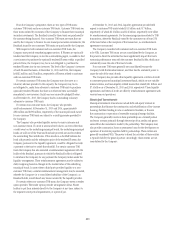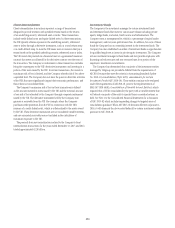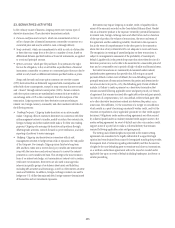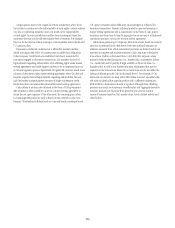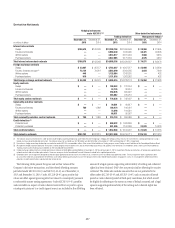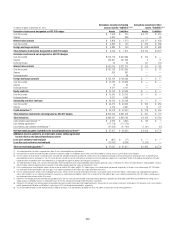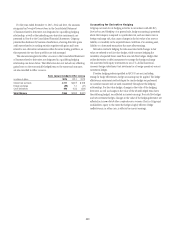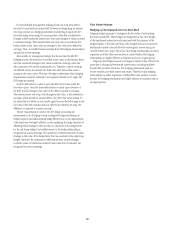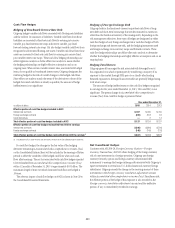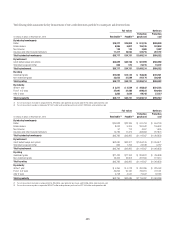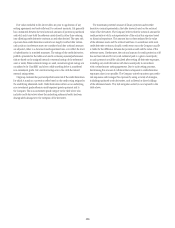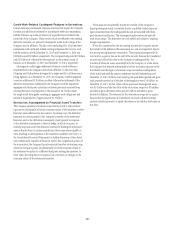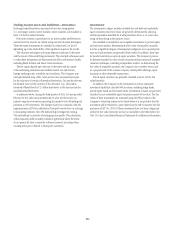Citibank 2015 Annual Report Download - page 261
Download and view the complete annual report
Please find page 261 of the 2015 Citibank annual report below. You can navigate through the pages in the report by either clicking on the pages listed below, or by using the keyword search tool below to find specific information within the annual report.
243
Cash Flow Hedges
Hedging of Benchmark Interest Rate Risk
Citigroup hedges variable cash flows associated with floating-rate liabilities
and the rollover (re-issuance) of liabilities. Variable cash flows from those
liabilities are converted to fixed-rate cash flows by entering into receive-
variable, pay-fixed interest rate swaps and receive-variable, pay-fixed
forward-starting interest rate swaps. Citi also hedges variable cash flows from
recognized and forecasted floating-rate assets. Variable cash flows from those
assets are converted to fixed-rate cash flows by entering into receive-fixed,
pay-variable interest rate swaps. These cash-flow hedging relationships use
either regression analysis or dollar-offset ratio analysis to assess whether
the hedging relationships are highly effective at inception and on an
ongoing basis. When certain variable interest rates, associated with hedged
items, do not qualify as benchmark interest rates, Citigroup designates the
risk being hedged as the risk of overall changes in the hedged cash flows.
Since efforts are made to match the terms of the derivatives to those of the
hedged forecasted cash flows as closely as possible, the amount of hedge
ineffectiveness is not significant.
Hedging of Foreign Exchange Risk
Citigroup locks in the functional currency equivalent cash flows of long-
term debt and short-term borrowings that are denominated in currencies
other than the functional currency of the issuing entity. Depending on the
risk management objectives, these types of hedges are designated as either
cash flow hedges of only foreign exchange risk or cash flow hedges of both
foreign exchange and interest rate risk, and the hedging instruments used
are foreign exchange cross-currency swaps and forward contracts. These
cash flow hedge relationships use dollar-offset ratio analysis to determine
whether the hedging relationships are highly effective at inception and on an
ongoing basis.
Hedging Total Return
Citigroup generally manages the risk associated with leveraged loans it
has originated or in which it participates by transferring a majority of its
exposure to the market through SPEs prior to or shortly after funding.
Retained exposures to leveraged loans receivable are generally hedged using
total return swaps.
The amount of hedge ineffectiveness on the cash flow hedges recognized
in earnings for the years ended December 31, 2015, 2014 and 2013 is not
significant. The pretax change in Accumulated other comprehensive
income (loss) from cash flow hedges is presented below:
Year ended December 31,
In millions of dollars 2015 2014 2013
Effective portion of cash flow hedges included in AOCI
Interest rate contracts $ 357 $ 299 $ 749
Foreign exchange contracts (220) (167) 34
Credit derivatives —2 14
Total effective portion of cash flow hedges included in AOCI $ 137 $ 134 $ 797
Effective portion of cash flow hedges reclassified from AOCI to earnings
Interest rate contracts $(186) $(260) $(700)
Foreign exchange contracts (146) (149) (176)
Total effective portion of cash flow hedges reclassified from AOCI to earnings(1) $(332) $(409) $(876)
(1) Included primarily in Other revenue and Net interest revenue on the Consolidated Income Statement.
For cash flow hedges, the changes in the fair value of the hedging
derivative remaining in Accumulated other comprehensive income (loss)
on the Consolidated Balance Sheet will be included in the earnings of future
periods to offset the variability of the hedged cash flows when such cash
flows affect earnings. The net loss associated with cash flow hedges expected
to be reclassified from Accumulated other comprehensive income (loss)
within 12 months of December 31, 2015 is approximately $0.3 billion. The
maximum length of time over which forecasted cash flows are hedged is
10 years.
The after-tax impact of cash flow hedges on AOCI is shown in Note 20 to
the Consolidated Financial Statements.
Net Investment Hedges
Consistent with ASC 830-20, Foreign Currency Matters—Foreign
Currency Transactions, ASC 815 allows hedging of the foreign currency
risk of a net investment in a foreign operation. Citigroup uses foreign
currency forwards, options and foreign-currency-denominated debt
instruments to manage the foreign exchange risk associated with Citigroup’s
equity investments in several non-U.S.-dollar-functional-currency foreign
subsidiaries. Citigroup records the change in the carrying amount of these
investments in the Foreign currency translation adjustment account
within Accumulated other comprehensive income (loss). Simultaneously,
the effective portion of the hedge of this exposure is also recorded in the
Foreign currency translation adjustment account and the ineffective
portion, if any, is immediately recorded in earnings.


